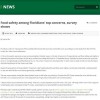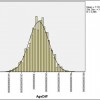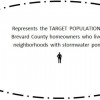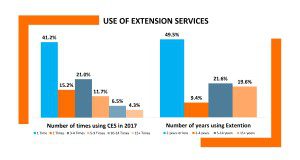This publication will briefly look at how the intent of a survey affects which types of questions should be asked and how the data can be analyzed to help address this intent. It is intended to provide guidance to Extension professionals, as well as persons in community organizations, who conduct surveys for program planning, improvement, and evaluation. Written by Colleen E. Gariton and Glenn D. Israel, and published by the UF/IFAS Department of Agricultural Education and Communication.
https://edis.ifas.ufl.edu/pd083
Tag: Glenn D. Israel
Identifying and Meeting the Needs of Extension’s Target Audiences
This new 4-page article provides an overview of the concept of target audiences as relating to Extension education and briefly presents concepts of audience analysis and educational content selection. In contrast to the general population, a target audience is comprised of people who can take some explicit action to help solve an identified problem addressed by an Extension program. Sometimes they are also those most affected by that problem. An understanding of the concept of target audiences paired with intentional selection of appropriate educational activities and content can support an impactful Extension program. Written by Laura A. Warner, Glenn D. Israel, and John M. Diaz, this article is a publication of the UF/IFAS Department of Agricultural Education and Communication.
http://edis.ifas.ufl.edu/wc336
Clients’ Experience with FCES: Widespread Satisfaction Tempered with Suggestions for Improvement
The Florida Cooperative Extension Service (FCES) provides a variety of information to clients throughout the state. In order to determine the extent of client satisfaction, the FCES conducts an annual survey. The survey was sent to a sample of clients who have received educational information between March and July, 2017. A total of 1,202 participants responded, and 94.9% of Extension clients reported that they were satisfied or very satisfied with the overall services provided. Many Extension clients also shared suggestions for improving services, including improved communication, increased advertising, and increased availability for some classes. In this five-page document from the UF/IFAS Department of Agricultural Education and Communication, Glenn D. Israel and Tiffany Henderson summarize the results of the survey and provide recommendations for how to improve Extension’s services.
http://edis.ifas.ufl.edu/wc326
Reporting Clientele Contacts in Workload
Each fall UF/IFAS faculty are asked to report on their Extension activities and accomplishments over the past year, including the contact made with Extension clientele through both direct and indirect methods. This five-page fact sheet describes how to report these interactions in Workload. Written by Diane Craig and Glenn D. Israel and published by the Department of Agricultural Education and Communication.
http://edis.ifas.ufl.edu/wc058
The Savvy Survey #6d: Constructing Indices for a Questionnaire

One of The Savvy Survey Series, this article will help Extension agents understand indexes and how to use them when evaluating an educational program. This six-page fact sheet provides an overview of constructing indices for a questionnaire. Specifically, it will discuss why composite measures like index numbers are important, what the index number means, the difference between indexes and scales, steps for the construction of indexes, and recommendations for use by Extension educators. Written by Anil Kumar Chaudhary and Glenn D. Israel, and published by the Agricultural Education and Communication Department.
http://edis.ifas.ufl.edu/pd069
The Savvy Survey #18: Group-Administered Surveys

Group-administered surveys are a great way to collect information from participants about the outcomes of an event or program. These kinds of surveys are best used for documenting short-term outcomes and can make use of an audience response system. This four-page fact sheet details how to develop a group-administered questionnaire, how to use an audience response system, and how to prepare and implement the survey. Written by Glenn D. Israel and Jessica L. Gouldthorpe, and published by the Agricultural Education and Communication Department.
http://edis.ifas.ufl.edu/pd082
The Savvy Survey #10: In-Person-Administered Surveys

In-person-administered surveys are a type of face-to-face interview that collects mainly quantitative data from a number of individuals and can be useful for collecting information from low-literacy audiences or obtaining very detailed information from agricultural producers or business owners about needs or program outcomes. A part of the Savvy Survey Series, this seven-page fact sheet presents the construction, development, and implementation of in-person surveys as well as how to prepare an introductory script, train interviewers, and manage the survey process. Written by Glenn D. Israel and Jessica L. Gouldthorpe, and published by the Agricultural Education and Communication Department.
http://edis.ifas.ufl.edu/pd074
Sampling the Evidence of Extension Program Impact

In order to evaluate their programs, Extension offices have to gather evidence about program outcomes and impacts. The first step of this process is to determine the appropriate amount of data needed, or the correct sample size. Using a sample can help Extension professionals save time, money, and labor because fewer people must be interviewed or surveyed; thus the complete set of data can be collected quickly. This nine-page fact sheet provides an overview of sampling procedures, beginning with how to determine the research problem, define the population, and decide whether to sample and going on to explain the different types of samples and how they are used. Written by Glenn D. Israel, and published by the Agricultural Education and Communication Department.
http://edis.ifas.ufl.edu/pd005
The Savvy Survey #7: Formatting Questionnaires

The Savvy Survey #7: Formatting Questionnaires is the seventh of seventeen Savvy Survey Series publications from state specialists with expertise in tailored design survey methodology. Developing a high-quality questionnaire is critical for collecting useful data. After selecting the best questions, the next step is to format them to produce the most effective questionnaire possible. This 7-page publication spotlights several considerations, including question order, layout for best visual appearance, and pagination. Written by Jessica L. Gouldthorpe and Glenn D. Israel, and published by the Agricultural Education and Communication Department.
https://edis.ifas.ufl.edu/pd071
The Savvy Survey #8: Pilot Testing and Pre-Testing Questionnaires
 It is a good practice to pre-test a questionnaire after the initial design and formatting are completed. Based on studies conducted by researchers, pre-testing can be implemented using various methods. A number of possible pre-testing methods are described in this 6-page fact sheet was written by Anil Kumar Chaudhary and Glenn D. Israel, and published by the UF Department of Agricultural Education and Communication, December 2014.
It is a good practice to pre-test a questionnaire after the initial design and formatting are completed. Based on studies conducted by researchers, pre-testing can be implemented using various methods. A number of possible pre-testing methods are described in this 6-page fact sheet was written by Anil Kumar Chaudhary and Glenn D. Israel, and published by the UF Department of Agricultural Education and Communication, December 2014.
http://edis.ifas.ufl.edu/pd072
The Savvy Survey #12: Telephone Surveys
 This publication provides a brief overview of how to develop and conduct a telephone survey to collect data. It assumed that a list of phone numbers, such as program registration lists, is available for conducting program evaluations or assessing needs. When volunteers or staff assist with the survey by interviewing respondents, this data collection method can be economical and effective. Careful attention is needed when developing the questionnaire and supporting materials and when orienting interviewers in order to obtain credible survey data. In the right situation, telephone surveys can be a valuable tool for Extension agents and specialists. This 7-page fact sheet was written by Glenn D. Israel and Jessica L. Gouldthorpe, and published by the UF Department of Agricultural Education and Communication, October 2014.
This publication provides a brief overview of how to develop and conduct a telephone survey to collect data. It assumed that a list of phone numbers, such as program registration lists, is available for conducting program evaluations or assessing needs. When volunteers or staff assist with the survey by interviewing respondents, this data collection method can be economical and effective. Careful attention is needed when developing the questionnaire and supporting materials and when orienting interviewers in order to obtain credible survey data. In the right situation, telephone surveys can be a valuable tool for Extension agents and specialists. This 7-page fact sheet was written by Glenn D. Israel and Jessica L. Gouldthorpe, and published by the UF Department of Agricultural Education and Communication, October 2014.
http://edis.ifas.ufl.edu/pd076
The Savvy Survey #17: Reporting Survey Findings
 Wrapping up the Savvy Survey Series, this fact sheet is the last of three publications that outline procedures to follow after implementing a survey. With the surveys in, data collected, and analyses conducted, the next logical step deals with communicating the results. Through communication, ideas and thoughts are shared with others in a manner that will be easily understood. In Extension, some common communication channels include the annual Report of Accomplishment (ROA), grant project reports, abstracts, and oral presentations. This 5-page fact sheet was written by Milton G. Newberry, III, Jessica L. Gouldthorpe, and Glenn D. Israel, and published by the UF Department of Agricultural Education and Communication, September 2014.
Wrapping up the Savvy Survey Series, this fact sheet is the last of three publications that outline procedures to follow after implementing a survey. With the surveys in, data collected, and analyses conducted, the next logical step deals with communicating the results. Through communication, ideas and thoughts are shared with others in a manner that will be easily understood. In Extension, some common communication channels include the annual Report of Accomplishment (ROA), grant project reports, abstracts, and oral presentations. This 5-page fact sheet was written by Milton G. Newberry, III, Jessica L. Gouldthorpe, and Glenn D. Israel, and published by the UF Department of Agricultural Education and Communication, September 2014.
http://edis.ifas.ufl.edu/pd081
The Savvy Survey #16: Data Analysis and Survey Results
 Continuing the Savvy Survey Series, this fact sheet is one of three focused on working with your survey data. In its most raw form, the data collected from surveys do not tell much of a story except who completed the survey, partially completed it, or did not respond at all. To truly interpret the data, it must be analyzed. Where does one begin the data analysis process? What computer program(s) can be used to analyze data? How should the data be analyzed? This publication serves to answer these questions. This 7-page fact sheet was written by Milton G. Newberry, III, Jessica L. Gouldthorpe, and Glenn D. Israel, and published by the UF Department of Agricultural Education and Communication, August 2014.
Continuing the Savvy Survey Series, this fact sheet is one of three focused on working with your survey data. In its most raw form, the data collected from surveys do not tell much of a story except who completed the survey, partially completed it, or did not respond at all. To truly interpret the data, it must be analyzed. Where does one begin the data analysis process? What computer program(s) can be used to analyze data? How should the data be analyzed? This publication serves to answer these questions. This 7-page fact sheet was written by Milton G. Newberry, III, Jessica L. Gouldthorpe, and Glenn D. Israel, and published by the UF Department of Agricultural Education and Communication, August 2014.
http://edis.ifas.ufl.edu/pd080
The Savvy Survey #15: Survey Responses and Data Entry
 This publication discusses the procedures for entering paper-based survey responses into an electronic database and preparing (or “cleaning”) all data, regardless of mode, for analysis. It also addresses data entry considerations for closed-ended questions (with response choices), partially-closed questions, and open-ended questions, since the types of questions used in the survey will also impact the data entry process.This 5-page fact sheet was written by Milton G. Newberry, III, Jessica L. Gouldthorpe, and Glenn D. Israel, and published by the UF Department of Agricultural Education and Communication, August 2014.
This publication discusses the procedures for entering paper-based survey responses into an electronic database and preparing (or “cleaning”) all data, regardless of mode, for analysis. It also addresses data entry considerations for closed-ended questions (with response choices), partially-closed questions, and open-ended questions, since the types of questions used in the survey will also impact the data entry process.This 5-page fact sheet was written by Milton G. Newberry, III, Jessica L. Gouldthorpe, and Glenn D. Israel, and published by the UF Department of Agricultural Education and Communication, August 2014.
http://edis.ifas.ufl.edu/pd079
Grant Writing: Tips and Advice for New Writers
 While grant writing is a highly useful and potentially lucrative skill, it can also be a challenge to learn how to successfully write grants. Moving through the entire process of creating and harnessing a new idea to building a collaborative team, and making sure the proposal itself is high quality and includes all the important pieces can be daunting for new grant writers. This 5-page fact sheet shares tips and walks you through the process of writing a collaborative grant by helping illuminate how to manage the idea creation, team building, and proposal writing stages of your grant writing experience. Written by Erica Odera, Sebastian Galindo-Gonzalez, Amy Harder, Glenn D. Israel, and Alexa J. Lamm, and published by the UF Department of Agricultural Education and Communication, May 2014.
While grant writing is a highly useful and potentially lucrative skill, it can also be a challenge to learn how to successfully write grants. Moving through the entire process of creating and harnessing a new idea to building a collaborative team, and making sure the proposal itself is high quality and includes all the important pieces can be daunting for new grant writers. This 5-page fact sheet shares tips and walks you through the process of writing a collaborative grant by helping illuminate how to manage the idea creation, team building, and proposal writing stages of your grant writing experience. Written by Erica Odera, Sebastian Galindo-Gonzalez, Amy Harder, Glenn D. Israel, and Alexa J. Lamm, and published by the UF Department of Agricultural Education and Communication, May 2014.
http://edis.ifas.ufl.edu/wc161
The Savvy Survey Series
 This month in this seventeen publication series based on Tailored Design Survey Methodology, we offer:
This month in this seventeen publication series based on Tailored Design Survey Methodology, we offer:
- #6a: General Guidelines for Writing Questionnaire Items
- #6b: Constructing Open-Ended Items for a Questionnaire
- #6c: Constructing Closed-Ended Items for a Questionnaire
- #14: Mixed Mode Surveys
These fact sheets are Glenn D. Israel and Jessica L. Gouldthorpe, and published by the UF Department of Agricultural Education and Communication, April 2014.
http://edis.ifas.ufl.edu/topic_series_savvy_survey
The Savvy Survey #11: Mail-Based Surveys
 As part of the Savvy Survey Series, this publication provides Extension faculty with an overview of the process that uses mail for sending and receiving questionnaires. Mail surveys can be an effective way to collect data for needs assessments in program planning or for follow-up surveys evaluating outcomes of Extension programs. Survey research consistently shows that mail surveys usually obtain as high or higher response rates than other methods. This fact sheet provides guidance for constructing the questionnaire, addressing visual design and formatting considerations, and implementing the survey. Extension faculty who incorporate best practices of questionnaire design and mail survey procedures will be able to achieve a high response rate and collect more useful data than those who don’t use these best practices. This 9-page fact sheet was written by Glenn D. Israel and Jessica L. Gouldthorpe, and published by the UF Department of Agricultural Education and Communication, October 2013.
As part of the Savvy Survey Series, this publication provides Extension faculty with an overview of the process that uses mail for sending and receiving questionnaires. Mail surveys can be an effective way to collect data for needs assessments in program planning or for follow-up surveys evaluating outcomes of Extension programs. Survey research consistently shows that mail surveys usually obtain as high or higher response rates than other methods. This fact sheet provides guidance for constructing the questionnaire, addressing visual design and formatting considerations, and implementing the survey. Extension faculty who incorporate best practices of questionnaire design and mail survey procedures will be able to achieve a high response rate and collect more useful data than those who don’t use these best practices. This 9-page fact sheet was written by Glenn D. Israel and Jessica L. Gouldthorpe, and published by the UF Department of Agricultural Education and Communication, October 2013.
http://edis.ifas.ufl.edu/pd071
The Savvy Survey #3: Successful Sampling
 As part of the Savvy Survey series, this publication provides Extension faculty with an overview of topics to consider when thinking about who should be surveyed. Topics in this publication include understanding the survey population, constructing the sampling frame, recognizing who exists outside the population of interest, and defining the sample. This 5-page fact sheet also provides insight on issues such as over-coverage and error that can arise because of poor sampling procedures. Written by Glenn D. Israel and Jessica L. Gouldthorpe, and published by the UF Department of Agricultural Education and Communication, October 2013.
As part of the Savvy Survey series, this publication provides Extension faculty with an overview of topics to consider when thinking about who should be surveyed. Topics in this publication include understanding the survey population, constructing the sampling frame, recognizing who exists outside the population of interest, and defining the sample. This 5-page fact sheet also provides insight on issues such as over-coverage and error that can arise because of poor sampling procedures. Written by Glenn D. Israel and Jessica L. Gouldthorpe, and published by the UF Department of Agricultural Education and Communication, October 2013.
http://edis.ifas.ufl.edu/pd063
The Savvy Survey #4: Details in the Design
 As part of the Savvy Survey Series, this publication provides an overview of important facets of the survey process. Topics covered include modes for collecting responses, strategies for contacting clients and personalizing contacts, and tips for using incentives. The ability of a survey to gather accurate and useful information for assessing program needs or evaluating program outcomes is greatly influenced by the survey’s design. Careful attention to detail is essential. This 4-page fact sheet was written by Glenn D. Israel and Jessica L. Gouldthorpe, and published by the UF Department of Agricultural Education and Communication, October 2013.
As part of the Savvy Survey Series, this publication provides an overview of important facets of the survey process. Topics covered include modes for collecting responses, strategies for contacting clients and personalizing contacts, and tips for using incentives. The ability of a survey to gather accurate and useful information for assessing program needs or evaluating program outcomes is greatly influenced by the survey’s design. Careful attention to detail is essential. This 4-page fact sheet was written by Glenn D. Israel and Jessica L. Gouldthorpe, and published by the UF Department of Agricultural Education and Communication, October 2013.
http://edis.ifas.ufl.edu/pd064
The Savvy Survey #2: Using Surveys in Everyday Extension Programming
 This second publication in the Savvy Survey Series provides Extension faculty with additional information about using surveys in their everyday Extension programming. The publication suggests how surveys can be used in needs and assets assessments to inform program development, as formative and summative evaluations to support program improvement, and as customer service tools to capture satisfaction within programming efforts. This publication also introduces the concept of using logic models to guide questionnaire development, while also discussing general data types (demographics, factual information, attitudes and opinions, behaviors and events). This 5-page fact sheet was written by Glenn D. Israel and Jessica L. Gouldthorpe, and published by the UF Department of Agricultural Education and Communication, October 2013.
This second publication in the Savvy Survey Series provides Extension faculty with additional information about using surveys in their everyday Extension programming. The publication suggests how surveys can be used in needs and assets assessments to inform program development, as formative and summative evaluations to support program improvement, and as customer service tools to capture satisfaction within programming efforts. This publication also introduces the concept of using logic models to guide questionnaire development, while also discussing general data types (demographics, factual information, attitudes and opinions, behaviors and events). This 5-page fact sheet was written by Glenn D. Israel and Jessica L. Gouldthorpe, and published by the UF Department of Agricultural Education and Communication, October 2013.
http://edis.ifas.ufl.edu/pd062



